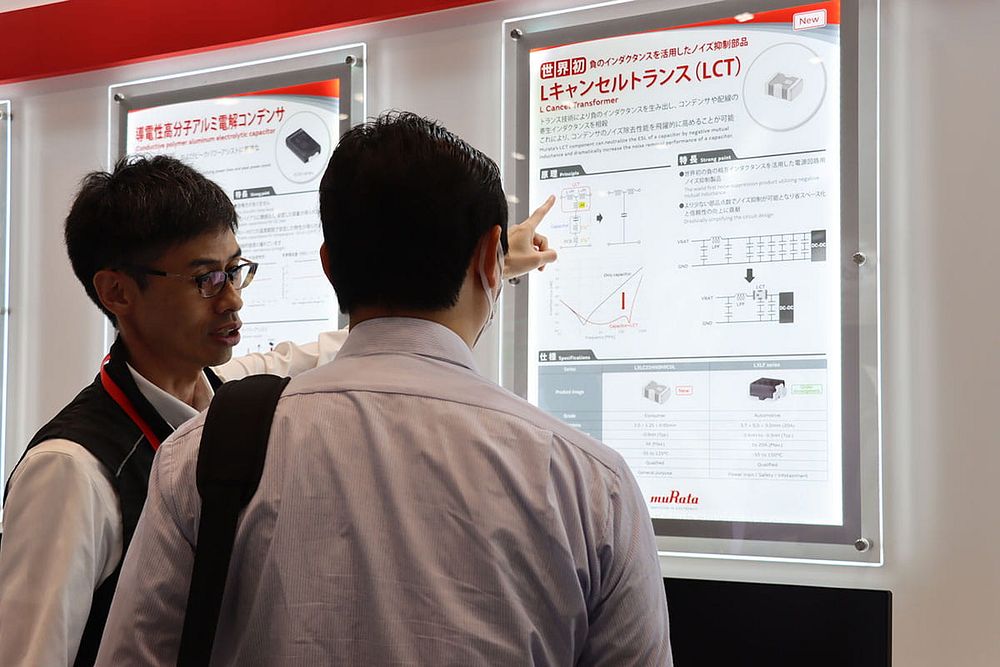
CO2 Adsorption Filters: Achieving Both Energy Saving and Comfort
“Please take a look. The CO2 concentration is steadily decreasing.” Many visitors gathered to watch the demonstration by Murata staff.
We unveiled a CO2 adsorption filter at this year's Automotive Engineering Exposition. This is a filter that aims to solve the problem of carbon dioxide (CO2), which is unavoidable as long as people are inside the car. We make this filter using a material with many nano-level holes that is called a “metal organic framework (MOF)” to adsorb and remove CO2 from inside the car. The demonstration showed that the CO2 concentration decreases by passing the air of a container containing CO2 through this product.

We depicted the environment inside the car and reproduced the decrease in the CO2 concentration


The impetus to develop this product comes from the increase in demand for energy saving as electric vehicles (EVs) become more widespread.
It is known that an increase in the CO2 concentration causes problems including breathlessness, physical weariness, and drowsiness. It is possible to improve these problems by using an automotive air conditioner to bring in outside air. However, air conditioners consume a lot of power. This has the disadvantage of leading to battery deterioration and a reduction in the driving range.
We make this product by combining a material that adsorbs CO2 with the MOF that has many small holes. This has made it possible to adsorb lots of CO2 efficiently. This reduces the number of times the air conditioner needs to be operated to bring in outside air. Thus, it saves energy.
In addition, advances in autonomous driving technologies are bringing about a transformation of the space inside cars. The inside of a car is not just a place for driving; it is also assumed that it will serve as a space to do things such as taking a break and working. The need for comfort is also increasing. A representative of Murata said, “If we reduce the frequency at which we bring in outside air, it will lead to energy saving. In addition, we can solve problems such as the smell of the outside air, pollen, and air conditioner noise. We want to capture this demand in future to use cars as a space to do things such as to relax and improve concentration.”
*This product is currently under development. We have not yet decided on a sales plan or other matters.
L Cancel Transformer (LCT): Contributing to Improved Safety and Space Saving with Noise Reduction
Automatic braking to reduce collision damage, pedestrian detection, parking assistance systems, and lane deviation detection… Such advancements in advanced driver assistance systems (ADAS) are leading to an increase in the number of electronic components being equipped in cars. On the other hand, the greater the number of electronic components equipped in cars, the greater the importance of noise suppression from a safety perspective. Murata also exhibited many solutions that will lead to the resolution of such issues at the Automotive Engineering Exposition.

The L Cancel Transformer contributes to space saving
One of those solutions is the L Cancel Transformer. The L Cancel Transformer is the world's first electronic component that uses a characteristic called “negative inductance” to remove noise. This improves the noise removal performance of capacitors. This contributes to space saving on boards by reducing the number of components.
Our new L Cancel Transformer product, which can improve the noise removal performance of capacitors, attracted a great deal of interest
Until now, noise suppression was achieved by lining up multiple capacitors. It is possible to remove noise with a smaller number of capacitors by using a L Cancel Transformer.
For example, we were able to confirm greater noise removal performance than before by placing one L Cancel Transformer in the circuit even when we had reduced the number of capacitors by 10 in an experiment using a drive recorder.
We anticipate that there will be demand for the L Cancel Transformer as a noise suppression component for power supply circuits. As cars become more electrified and electronically controlled, the L Cancel Transformer kills two birds with one stone: it suppresses noise that causes malfunctions in cars and also contributes to an expansion in the space inside cars through space saving on the board.
Optimization of Tire Management with RFIDs: Also Contributing to Resolving Logistics Issues
There was also an exhibit to prepare for the shortage in transport capacity with overland transport. This is a tire with a built-in radio frequency identification (RFID) module that can exchange information through radio communication. Regulations on overtime work for truck drivers were tightened in April 2024 in Japan. There are concerns that this will lead to a shortage in transport capacity. More efficient work styles are being required. Against this background, this is a product that reduces the effort spent by transportation operators on inspecting and managing tires.

We exhibited an actual tire with a built-in RFID module at the Automotive Engineering Exposition. Murata staff performed a demo of reading tire information with a dedicated terminal.


